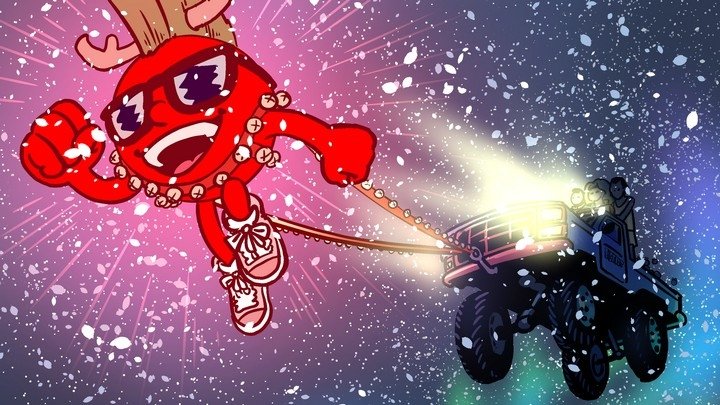"It's out there..." 22 years since the American launch of the Sega Saturn

Yes, it's May 11th! The anniversary of one of the most shocking console launches in the history of video games. On this day in 1995, at the very first Electronics Entertainment Expo (E3), Sega of America CEO Tom Kalinske announced that 30,000 Sega Saturns were already in stores across America, complete with a copy of Virtua Fighter, for the cost of $399 -- a surprise release that came four months before the proposed release date of September 2nd (or "Saturnday" as it was known). It's something of an infamous event, one that's almost seen as the height of video game drama -- especially when, during Sony's conference on the very same day, head of development Steve Race interrupted a purposefully dreary presentation by Olaf Olafsson (remember him from yesterday?) to say the number "$299", thus changing the course of gaming history forever and leaving ol' Mr. Kalinske with a mouth as agape as The Mask's.
The history is well documented, and we know the fallout from this day well -- the Saturn's surprise launch annoyed retailers such as Best Buy and Walmart who did not receive any of the 30,000 Saturns, there were only a handful of launch titles available for the system for some months afterwards, and ultimately the move gave Sega barely any advantage over Sony in the new 32-bit console war -- indeed, once the PlayStation arrived on 9th September, it soon picked the Saturn apart and built up a huge lead from which Sega had little hope of ever recovering. One thing that's less talked about, perhaps, is how the Saturn's launch went over in Europe -- something all the more frustrating considering just how similar the European history of the Saturn is to the American history.

Much like in America, the Saturn launched early here as well -- arriving on July 8th, 1995, albeit this time with a mere two month advantage over the PlayStation. Not that this advantage was anything that helped -- unfortunately for Sega, a lot of people made the decision to wait two months for Sony's machine to come out. This is perhaps quite the surprise considering where Sega stood in Europe -- by and large they were the leading console brand in Europe with key areas such as the United Kingdom, France and Germany belonging to Sega, meaning that the Mega Drive had overall beaten the Super Nintendo in terms of sales over there. They had control, and yet they lost it in mere months.
On paper, the games that the Saturn launched with don't look all that bad -- the European lineup was, much like the North American one, led by Virtua Fighter and Daytona USA, with Clockwork Knight and Worldwide Soccer filling out the list. Unlike America, Panzer Dragoon's release was separated from this quartet and allowed to stand on its own -- possibly wise considering that there was little else scheduled between the July launch and September. Panzer Dragoon may well have been the most impressive early Saturn title of them all both from a technical and a gameplay perspective, but as an entirely new franchise it would have been quite the ask for it to battle with PlayStation launch titles like Tekken and Ridge Racer -- both of which were more recognised in Europe than Virtua Fighter and Daytona were. One also wonders how much of Sega's failings in the region boiled down to a simple yet significant lack of Sonic.
Was it all a question of marketing? Perhaps there was a sense of complacency hanging around Sega's status in Europe, with only a few million dollars assigned to Sega's marketing budget for the region. Sony, meanwhile, set $20 million aside for the console's European launch, which included famed adverts such as SAPS (the Society Against PlayStation), which in the coming years would evolve into a highly reactive, trend-setting and often controversial marketing drive that appealed to the young adult market in a way that Sega wanted to do, but were never able to emulate -- Sega weren't ever ones for things like sticking their machines in night clubs, commissioning posters with a spaced out Sara Cox bleeding from the nose, or passing around perforated cards that could be turned into roaches for your joint at Glastonbury festival.

In the end, the story of the Saturn's launch and its battle with the PlayStation in Europe is, if anything, an even more decisive victory than the more famed American story, even if it lacks those dramatic events. Sega got it, they had it, and then they lost it -- it is estimated that the Sega Saturn sold an estimated one million units in Europe, a rather shocking number compared to the 10.4 million sales that the Mega Drive had generated in the continent, and a drop in the ocean compared to the 40.12 million consoles that Sony shipped over here. Over the years the Saturn has developed a reputation as a very fine console indeed, especially when it comes to 2D games, and the system's cache as a retro games machine is surely much higher than it ever was now as opposed to the status it had when it was actually released -- and as the rules of retro start to apply to the 2D and 3D games of the 32-bit generation, that's only going to increase. Still, knowing what we know about the system now only makes it more surprising to look back on just how quickly Sega managed to lose the status that it had back in 1995 -- they tried to draw Sony out, but before they knew it their house started crumbling around them as if someone had just tippex-ed "Sony" over their name. Such are the fickle ways of video game marketing.
Fancy a bit more info on the launch of the Saturn and how badly things went for Sega in '95? Well, not to be a total self-promoting arsehole or anything but I do have a video on the subject. It's called Sega in 1995: What the F**k is Going On?




